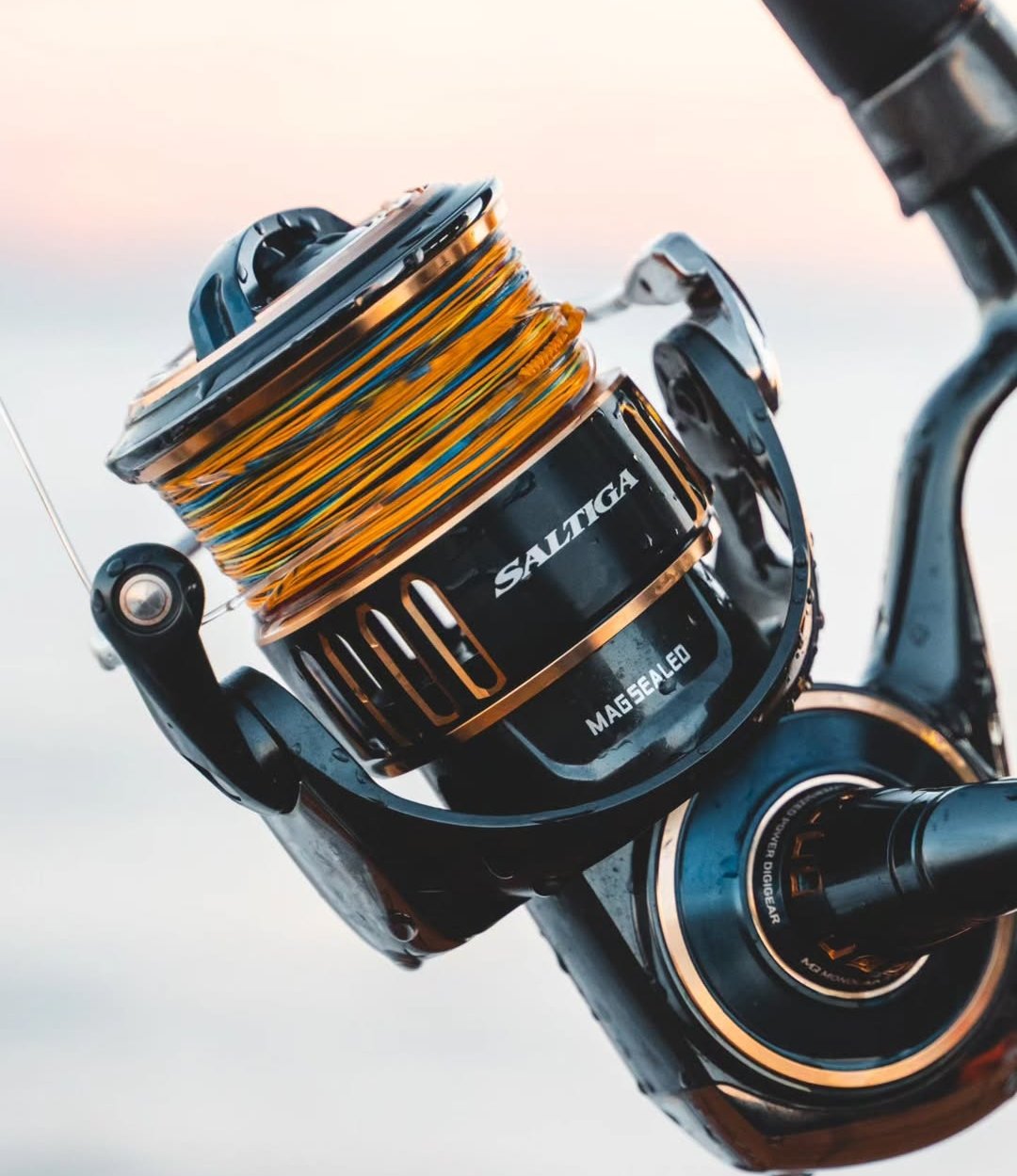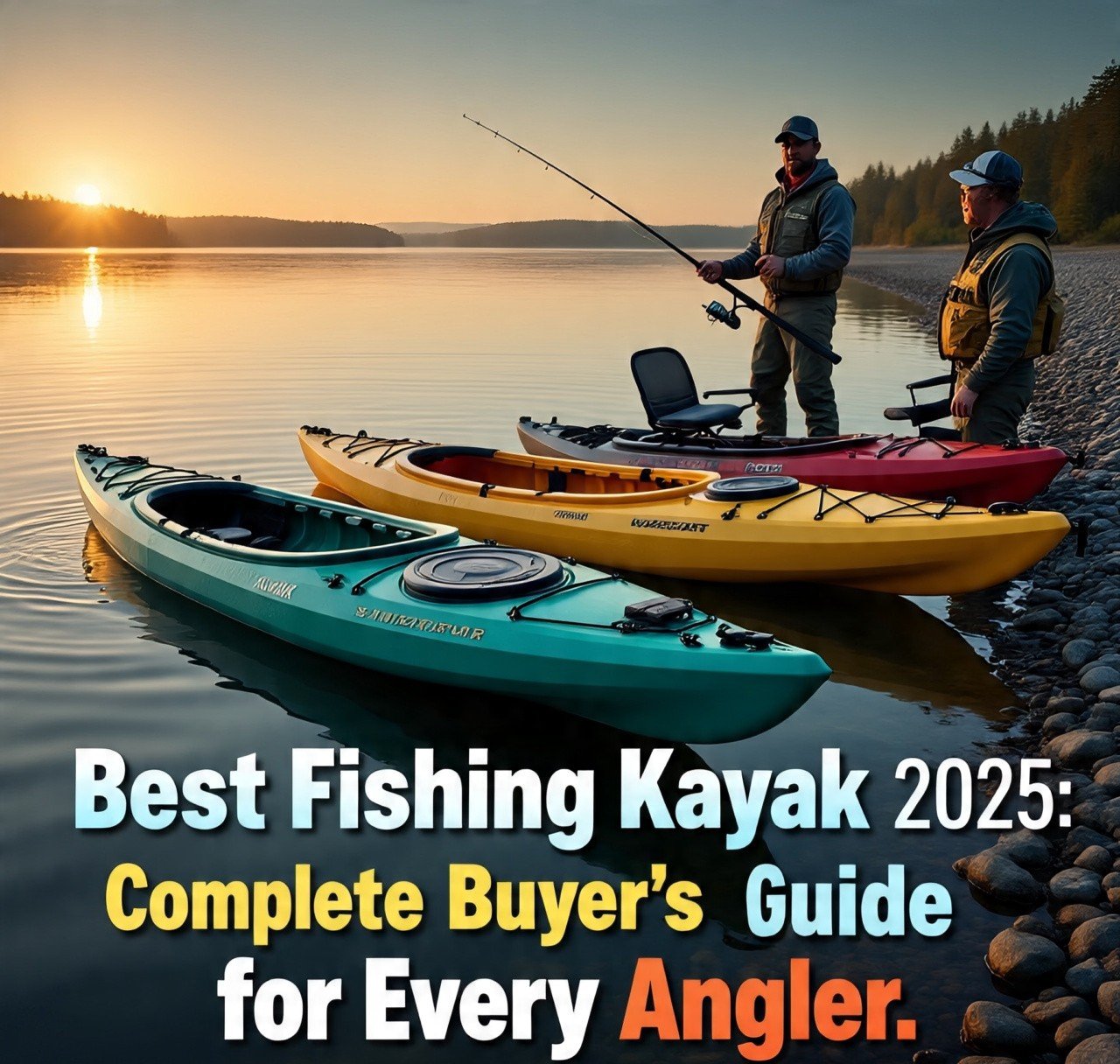
Picture this: dawn breaks over glassy water as you silently glide into that perfect fishing spot, rod holders loaded and tackle box within arm’s reach. Your kayak cuts through the water like a knife, stable enough to stand and cast while nimble enough to chase schools of fish into shallow coves where powerboats can’t follow. After two decades of testing over 200 fishing kayaks across saltwater flats, mountain lakes, and everything in between, one truth remains constant: the right fishing kayak transforms good anglers into great ones.
The 2025 fishing kayak market has exploded with innovation. New pedal drive systems offer 30% more efficiency, advanced hull designs provide unprecedented stability, and smart storage solutions maximize every inch of space. Whether targeting bass in shallow creeks or battling tuna offshore, today’s best fishing kayak 2025 deliver performance that would have seemed impossible just five years ago.
Key Takeaways
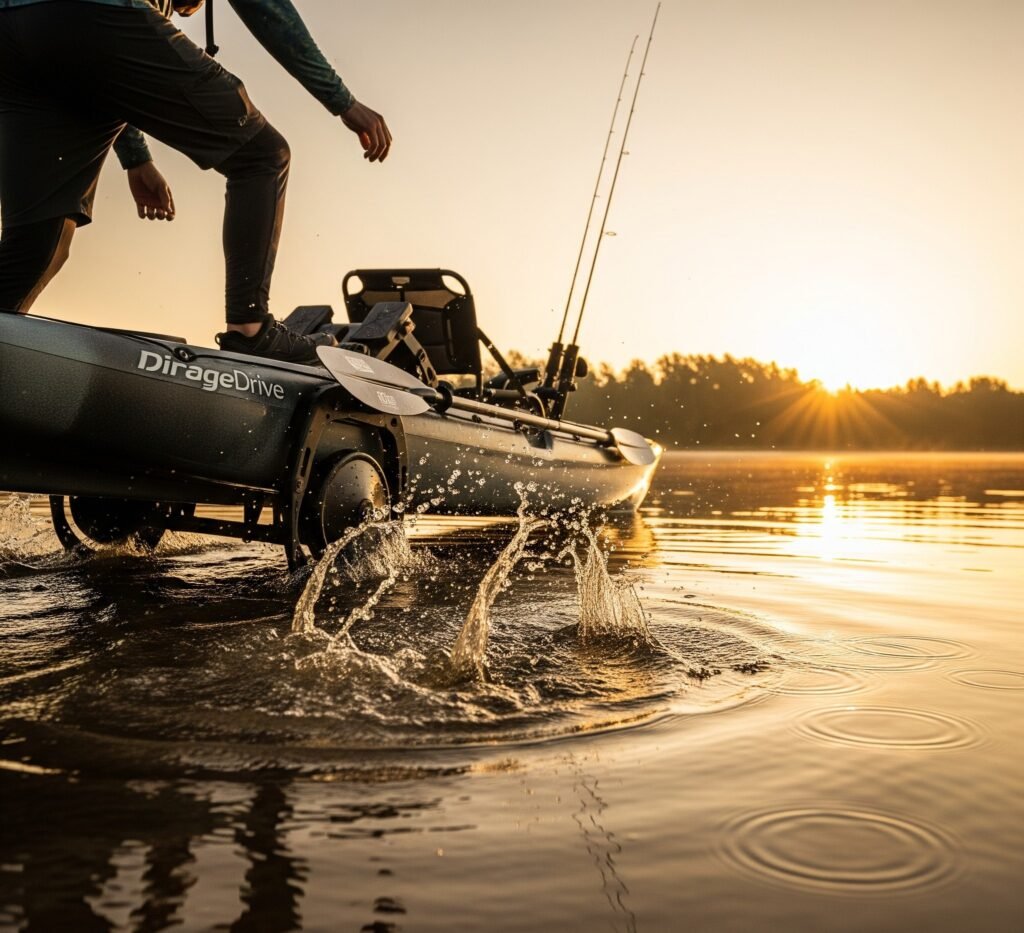
- Pedal drive kayaks now dominate the premium market, offering hands-free propulsion and speeds up to 6 mph
- Budget-conscious anglers can find excellent fishing kayaks under $800 without sacrificing essential features
- Stability improvements in 2025 models allow confident standing and casting for anglers of all skill levels
- Modular storage systems and integrated electronics mounts have become standard across all price ranges
- Weight capacity calculations should follow the formula: (Your weight + gear) × 1.3 = minimum kayak capacity needed
🎯 Quick Selection Guide: Find Your Perfect Match
Best Overall: Hobie Pro Angler 14 ($3,200-$3,500)
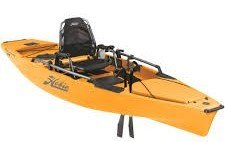
The gold standard for serious anglers. MirageDrive 360 propulsion, 600-pound capacity, and unmatched stability.
Best Budget Option: Lifetime Tamarack Angler 100 ($399-$499)
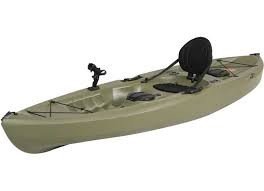
Incredible value with multiple rod holders, storage compartments, and surprising stability for under $500.
Best Premium Choice: Native Watercraft Slayer Max 12.5 ($2,800-$3,200)
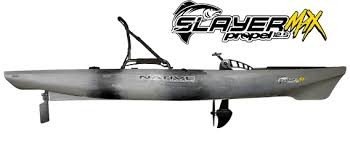
Tournament-grade performance with innovative tunnel hull design and premium appointments.
Best for Beginners: Old Town Loon 106 ($649-$749)
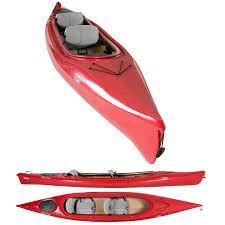
Forgiving design with excellent initial stability and intuitive handling characteristics.
Best Pedal Drive: Perception Pescador Pilot 12.0 ($1,899-$2,199)
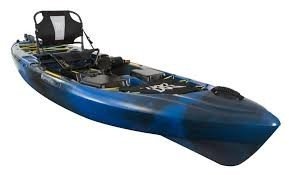
Affordable entry into pedal kayaking with proven PDL Drive system and spacious cockpit.
Best Inflatable: Sea Eagle 385ft FastTrack ($899-$1,099)
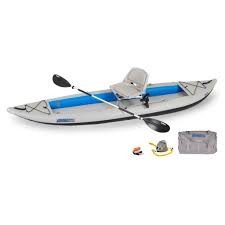
Rigid performance in a packable design, perfect for apartment dwellers and travelers.
⚖️ Essential Buying Factors: Making the Right Choice
Stability vs. Speed Trade-offs
The eternal kayak fishing dilemma centers on beam width. Kayaks 32+ inches wide provide rock-solid stability for standing and casting but sacrifice speed and tracking. Models in the 28-31 inch range offer the sweet spot for most anglers, while sub-28 inch beams favor speed over stability.
Stability Ratings by Width:
- 36″+ width: Pontoon-like stability, ideal for beginners
- 32-35″ width: Excellent stability, slight speed penalty
- 28-31″ width: Balanced performance for most conditions
- Under 28″ width: Speed-focused, requires experience
Propulsion System Comparison
| Propulsion Type | Pros | Cons | Best For |
|---|---|---|---|
| Traditional Paddle | Silent approach, lightweight, budget-friendly | Requires constant paddling, limits fishing time | Stealth fishing, budget builds |
| Pedal Drive | Hands-free operation, higher speeds, precise maneuvering | Higher cost, maintenance needs, weight penalty | Active fishing, covering water |
| Motor Mount | Maximum speed and range, effortless travel | Noise, regulations, battery/fuel costs | Large waters, mobility issues |
Storage Capacity Planning
Modern fishing kayaks excel at organization. Look for kayaks offering:
- 4-6 rod holders minimum (flush mount and adjustable)
- Sealed bow/stern hatches for dry storage
- Open cockpit wells for tackle crates and coolers
- Bungee rigging for quick-access gear
- Electronics mounting for fish finders and GPS
Weight Capacity Reality Check
Manufacturers often overstate practical capacity. Use this formula for real-world performance:
(Your weight + gear weight) × 1.3 = Minimum rated capacity
A 200-pound angler with 50 pounds of gear needs a kayak rated for at least 325 pounds to maintain proper performance and safety margins.
🛶 Kayak Categories Deep Dive
Kayak Type Comparison
Compare sit-on-top vs sit-inside kayaks
Sit-on-Top
Sit-Inside
Most fishing kayaks utilize sit-on-top designs for their practical advantages. Sit-inside fishing kayaks work best for cold-weather fishing or long-distance touring.
Pedal Drive Systems Revolution
Hobie MirageDrive 360
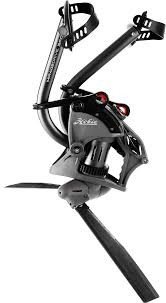
The original and still the best. Fin-based propulsion mimics penguin swimming for efficiency. 360-degree steering capabilities and reverse functionality. Annual maintenance costs around $100-150.
Old Town PDL (Propel Drive System)
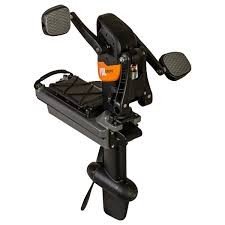
Propeller-based system offers higher top speeds (up to 6 mph) but requires more maintenance. Excellent for covering large bodies of water quickly.
Perception Pilot Drive
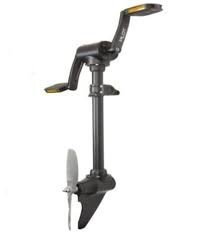
Budget-friendly propeller system with tool-free removal. Slightly less efficient than premium options but offers excellent value.
2025 Inflatable vs Rigid Fishing Kayaks
| Feature | Inflatable Kayaks | Rigid Kayaks |
|---|---|---|
| Storage & Transport | Closet-sized bags, apartment-friendly | Requires roof rack, garage space |
| Modern inflatables pack down to 3×2 feet, perfect for urban living. Rigid kayaks need 12+ feet of storage space. | ||
| Setup Time | 15-20 minutes with electric pump | Ready to launch immediately |
| Electric pumps have revolutionized setup time. Rigid kayaks win on convenience but inflatables are catching up fast. | ||
| Performance | Drop-stitch creates rigid platform | Traditional superior tracking |
| 2025 drop-stitch technology creates surprisingly rigid platforms that rival traditional hulls for stability and performance. | ||
| Fishing Features | Modular accessories system | Fixed mounting points |
| Modern inflatables offer versatile D-ring systems and modular mounts that adapt to different fishing styles and conditions. | ||
| Durability | Puncture-resistant materials | Proven long-term reliability |
| While rigid kayaks have decades of proven durability, modern inflatable materials are surprisingly tough and repairable in the field. | ||
| Total Cost | Lower entry cost, no transport gear | Higher initial investment + accessories |
| Inflatables eliminate roof rack, storage, and transport costs. Total ownership cost often favors inflatables significantly. | ||
2025 Verdict
Inflatable fishing kayaks have reached a tipping point. Drop-stitch construction and modular accessories make them serious alternatives to rigid kayaks, especially for urban anglers with storage constraints. The 15-20 minute setup time is now the main trade-off for apartment-friendly storage and lower total cost of ownership.
Fishing with inflatable kayaks has gained serious credibility among space-constrained anglers.
🏆 Top 2025 Fishing Kayak Recommendations
Premium Category ($2,500+)
Hobie Pro Angler 14 – $3,400

- Specifications: 14’6″ × 36″ × 600 lbs capacity
- Standout Features: MirageDrive 360, Vantage CT seat, massive storage
- Best For: Serious anglers wanting the ultimate fishing platform
- Pros: Unmatched stability, premium components, excellent resale value
- Cons: Heavy (120 lbs), expensive, requires roof rack system
Native Watercraft Slayer Max 12.5 – $3,000
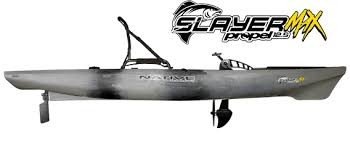
- Specifications: 12’6″ × 34″ × 550 lbs capacity
- Standout Features: Tunnel hull design, integrated rudder, premium seat
- Best For: Tournament anglers prioritizing performance
- Pros: Exceptional tracking, innovative storage, rock-solid build
- Cons: Learning curve for tunnel hull, premium price point
Mid-Range Category ($1,200-$2,500)
Old Town Sportsman AutoPilot 136 – $2,200
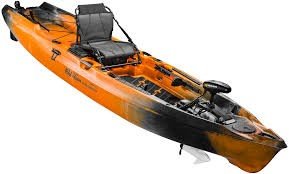
- Specifications: 13’6″ × 34″ × 500 lbs capacity
- Standout Features: Motorized drive with GPS autopilot, smartphone control
- Best For: Tech-savvy anglers wanting autonomous positioning
- Pros: Hands-free operation, precise positioning, innovative technology
- Cons: Battery dependency, complex electronics, higher maintenance
Perception Pescador Pilot 12.0 – $2,000

- Specifications: 12′ × 32.5″ × 475 lbs capacity
- Standout Features: PDL Drive system, spacious cockpit, comfortable seating
- Best For: First-time pedal kayak buyers
- Pros: Proven drive system, excellent value, stable platform
- Cons: Heavier than paddle kayaks, propeller vulnerability
Budget Category ($500-$1,200)
Lifetime Tamarack Angler 100 – $450

- Specifications: 10′ × 31″ × 275 lbs capacity
- Standout Features: Multiple rod holders, front/rear storage, adjustable seat
- Best For: Budget-conscious beginners and youth anglers
- Pros: Incredible value, lightweight, easy handling
- Cons: Limited capacity, basic components, shorter length
Pelican Catch 110 – $599
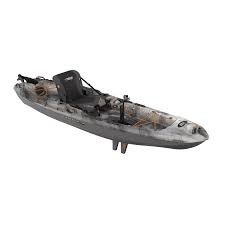
- Specifications: 11′ × 32″ × 325 lbs capacity
- Standout Features: Twin-Arcs hull, multiple storage areas, comfortable seat
- Best For: Recreational anglers wanting quality on a budget
- Pros: Stable platform, good storage, reasonable price
- Cons: Paddle-only propulsion, basic hardware
Specialty Categories
Best Tandem: Old Town Loon 160T – $1,200
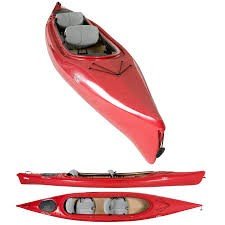
Perfect for couples or parent/child fishing adventures. Tandem kayaks for fishing offer shared experiences and gear capacity.
Best Ocean Kayak: Hobie Outback – $2,800
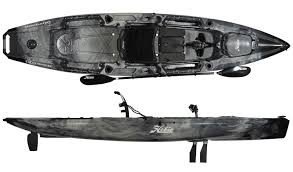
Designed for saltwater challenges with corrosion-resistant hardware and exceptional seaworthiness. Learn more about ocean fishing kayaks.
📊 Technical Specifications Comparison
| Model | Length | Width | Weight | Capacity | Price Range |
|---|---|---|---|---|---|
| Hobie Pro Angler 14 | 14’6″ | 36″ | 120 lbs | 600 lbs | $3,200-$3,500 |
| Native Slayer Max | 12’6″ | 34″ | 95 lbs | 550 lbs | $2,800-$3,200 |
| Perception Pilot | 12′ | 32.5″ | 85 lbs | 475 lbs | $1,899-$2,199 |
| Old Town AutoPilot | 13’6″ | 34″ | 106 lbs | 500 lbs | $2,000-$2,400 |
| Lifetime Tamarack | 10′ | 31″ | 52 lbs | 275 lbs | $399-$499 |
| Pelican Catch 110 | 11′ | 32″ | 57 lbs | 325 lbs | $549-$649 |
🎣 Find Your Perfect Fishing Kayak
What’s your kayak fishing experience level?
What’s your budget range?
Preferred propulsion method?
Primary fishing waters?
Most important feature?
Hull Design Types Explained
Pontoon Hulls: Maximum stability with twin hulls connected by a deck. Excellent for standing but slower speeds.
V-Hull Design: Traditional pointed bow for speed and tracking. Less initial stability but better secondary stability.
Catamaran Style: Combines stability benefits of pontoons with improved speed characteristics.
Tunnel Hull: Advanced design with recessed center channel. Provides exceptional tracking while maintaining stability.
📏 Sizing and Fit Guide
Length Selection by Angler Profile
10-11 feet: Ideal for smaller anglers (under 5’6″) or those prioritizing maneuverability in tight spaces. Easier transport and storage.
12-13 feet: Sweet spot for most anglers. Balances speed, stability, and storage capacity effectively.
14+ feet: Best for larger anglers (over 6’2″) or those covering significant distances. Maximum gear capacity and speed potential.
Cockpit Comfort Factors
- Seat adjustability: Look for multiple position options and lumbar support
- Leg room: Ensure comfortable positioning without cramping
- Foot brace system: Adjustable foot pegs improve paddling efficiency
- Thigh padding: Reduces pressure points during long sessions
Weight Capacity Calculation Example
Scenario: 180 lb angler with typical fishing gear
- Angler weight: 180 lbs
- Tackle and gear: 40 lbs
- Cooler and fish: 25 lbs
- Safety equipment: 10 lbs
- Total: 255 lbs × 1.3 = 332 lb minimum capacity needed
This calculation ensures the kayak performs optimally without being overloaded.
🎣 Essential Accessories and Cost Planning
Must-Have Accessories ($200-$400)
Kayak Fishing Cost Calculator
Plan your budget and select the accessories you need
🧽 Maintenance and Care Tips
Routine Cleaning Protocol
After Each Use:
- Rinse with fresh water, especially after saltwater exposure
- Remove standing water from cockpit and storage areas
- Wipe down seat and hardware with damp cloth
Weekly Deep Clean:
- Scrub hull with mild soap and soft brush
- Inspect and lubricate moving parts
- Check hardware for corrosion or looseness
Pedal Drive Maintenance
Monthly Tasks:
- Remove and rinse drive unit thoroughly
- Inspect fins or propeller for damage
- Lubricate pivot points per manufacturer specs
Annual Service:
- Replace drive belts and seals
- Professional inspection of gear systems
- Expected costs: $100-$200 annually
Storage Best Practices
Indoor Storage (Preferred):
- Store in garage or shed away from UV exposure
- Support hull at multiple points to prevent warping
- Remove batteries from electronics
Outdoor Storage:
- Use UV-resistant kayak cover
- Store upside down or on side to prevent water accumulation
- Secure against wind with proper tie-downs
Seasonal Preparation
Winter Storage:
- Thorough cleaning and drying
- Remove and store drive systems indoors
- Apply protectant to rubber seals and gaskets
Spring Launch:
- Inspect hull for winter damage
- Test all moving parts and electronics
- Update safety equipment as needed
🎯 Specialized Fishing Applications
Fly Fishing from Kayaks
Fly fishing from a kayak requires specific considerations:
Platform Requirements:
- Wide beam (33+ inches) for casting stability
- Low profile seating to avoid line tangles
- Minimal deck rigging preventing fly line snags
- Quick-access rod storage for multiple setups
Recommended Models:
- Native Slayer 13: Purpose-built for fly fishing
- Hobie Compass: Stable platform with clean deck layout
- Jackson Big Rig HD: Standing-focused design
Saltwater Fishing Considerations
Ocean fishing demands enhanced durability and safety features:
Corrosion Resistance:
- Stainless steel or aluminum hardware
- UV-resistant hull materials
- Sealed bearing systems in moving parts
Safety Equipment:
- Marine-grade VHF radio
- GPS with waypoint capability
- Enhanced flotation and signaling devices
Hull Requirements:
- Higher volume for rough water buoyancy
- Sealed storage protecting gear from spray
- Adequate freeboard preventing swamping
Tournament Fishing Setup
Competitive anglers need maximum efficiency and organization:
Essential Features:
- Multiple rod storage for quick technique changes
- Live well systems for keeping tournament fish healthy
- Precise measurement tools built into hull design
- Camera mounts for documenting catches
Recommended Accessories:
- Tournament-legal measuring boards
- Aerator systems for live wells
- Quick-release anchoring for rapid repositioning
- Waterproof storage for electronics and documentation
🔧 Customization and Modifications
Popular Kayak Modifications
Electronics Integration:
Modern kayaks accommodate extensive electronics with factory-installed wiring and mounting points. Popular additions include:
- Fish finders with through-hull transducers
- GPS chartplotters for navigation and waypoints
- VHF radios for safety and communication
- Action cameras for documenting adventures
Storage Enhancements:
- Milk crate systems with custom rod holders
- Gear tracks for adjustable accessory mounting
- Cooler tie-down systems securing refreshments
- Additional rod holders beyond factory equipment
DIY vs. Professional Installation
DIY-Friendly Projects:
- Rod holder installation
- Basic gear track mounting
- Anchor trolley systems
- Simple lighting additions
Professional Installation Recommended:
- Through-hull transducer mounting
- Complex wiring harnesses
- Structural modifications
- Motor mount installations
Modification Costs and Considerations
Budget Modifications ($50-$200):
- Additional rod holders: $15-$30 each
- Gear track sections: $25-$50 per foot
- Basic lighting: $40-$80
- Anchor trolley: $40-$70
Advanced Modifications ($200-$800):
- Fish finder installation: $200-$500
- Motor mount systems: $150-$400
- Custom storage solutions: $100-$300
- Professional wiring: $100-$250
Always consider modification impact on warranty coverage and resale value before proceeding.
📈 Market Trends and Future Outlook
2025 Technology Trends
Smart Kayak Integration:
Bluetooth connectivity now links kayak systems with smartphone apps for:
- GPS autopilot control maintaining position or following routes
- Fish finder data sharing between devices and cloud storage
- Performance monitoring tracking speed, distance, and calories
- Social features sharing locations and catches with friends
Advanced Materials:
- Carbon fiber construction reducing weight by 20-30%
- Thermoformed plastics improving durability and appearance
- Foam core hulls enhancing insulation and buoyancy
- Recycled materials addressing environmental concerns
Emerging Propulsion Technologies
Electric Assist Systems:
Battery-powered assistance supplements pedaling or paddling:
- Boost modes for fighting current or covering distance
- Trolling speeds maintaining precise fishing speeds
- Emergency power ensuring safe return in adverse conditions
Hybrid Drive Systems:
Combining pedal and electric power for maximum versatility:
- Seamless transitions between human and electric power
- Extended range through efficient power management
- Regenerative charging during pedaling or sailing
Sustainability Initiatives
Eco-Friendly Manufacturing:
- Recycled hull materials reducing environmental impact
- Local production minimizing transportation emissions
- Modular designs enabling component replacement vs. full kayak replacement
- Take-back programs recycling end-of-life kayaks
Responsible Fishing Features:
- Catch documentation systems promoting conservation
- Live release optimization keeping fish healthy
- Habitat protection through low-impact fishing methods
❓ Frequently Asked Questions
The Lifetime Tamarack Angler 100 at $450 offers exceptional value for new anglers. Its 31-inch beam provides confidence-inspiring stability while multiple rod holders and storage areas accommodate essential fishing gear. The lightweight design (52 lbs) makes transport manageable for most vehicles.
For slightly more budget, the Old Town Loon 106 ($649-$749) provides better build quality and improved tracking for longer fishing sessions.
Pedal drives excel when covering large areas or fishing in current, but aren’t essential for success. Traditional paddle kayaks offer advantages including:
- Silent approach for spooky fish
- Lower maintenance costs and complexity
- Reduced weight for easier transport
- Budget savings for more fishing gear
Consider pedal drives if fishing large lakes, fighting current regularly, or having mobility limitations affecting paddling ability.
Modern fishing kayaks with 32+ inch beams allow confident standing for most anglers. Key stability factors include:
- Primary Stability: Initial steadiness when boarding
- Secondary Stability: Resistance to capsizing when leaned over
- Hull Design: Pontoon and catamaran styles offer maximum standing stability
Practice standing in shallow, calm water before attempting in fishing conditions. Even stable kayaks require developing balance and confidence.
Most fishing kayaks can accommodate small electric motors, but several factors matter:
- Hull Design: Flat transoms work best for motor mounting
- Weight Capacity: Motors add 20-40 lbs plus battery weight
- Stability: Motors raise center of gravity affecting handling
- Regulations: Check local laws regarding motorized watercraft
Popular options include trolling motors (30-55 lb thrust) and kayak-specific outboards like the Torqeedo Travel series.
2025 Improvements Include:
- Enhanced pedal drives with 20-30% efficiency gains
- Integrated electronics mounting becoming standard
- Modular storage systems for better organization
- Improved seat designs with better lumbar support
- Lighter materials reducing overall kayak weight
Most changes are evolutionary rather than revolutionary. Previous model years often offer excellent value as new models arrive.
🏁 Conclusion: Your Next Steps to Kayak Fishing Success
Selecting the best fishing kayak 2025 requires balancing personal needs, fishing style, and budget constraints. Whether choosing a budget-friendly paddle kayak or investing in a premium pedal drive system, success comes from matching kayak capabilities to fishing goals.
For beginners, start with stable, affordable options like the Lifetime Tamarack Angler 100 or Old Town Loon 106. These proven platforms build confidence while providing room for skill development.
Intermediate anglers ready to upgrade should consider pedal drive systems like the Perception Pescador Pilot 12.0 or Old Town Sportsman AutoPilot 136. These kayaks unlock new fishing opportunities through enhanced mobility and positioning.
Experienced anglers demanding maximum performance will appreciate premium options like the Hobie Pro Angler 14 or Native Watercraft Slayer Max 12.5. These tournament-grade platforms justify their investment through superior features and long-term durability.
Essential next steps:
- Test paddle your top choices at local dealers or demo events
- Calculate total costs including accessories and maintenance
- Consider storage and transportation requirements for your situation
- Start with safety equipment before adding convenience accessories
- Join local kayak fishing communities for ongoing support and advice
The kayak fishing community welcomes newcomers enthusiastically. Local clubs, online forums, and social media groups provide invaluable knowledge sharing and fishing partnerships. Many lifelong friendships begin with shared kayak fishing adventures.
Remember that the best fishing kayak is the one that gets used regularly. A modest kayak on the water beats the perfect kayak in the garage every time. Start your kayak fishing journey today, and discover why millions of anglers have embraced this exciting and rewarding fishing method.
For detailed reviews of specific models mentioned in this guide, visit our comprehensive fishing kayak reviews section. Whether targeting bass, saltwater species, or exploring new fishing techniques, the right kayak opens unlimited angling possibilities.



